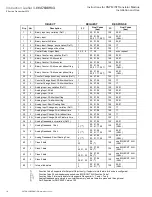
8
Instruction Leaflet IL
66A7638H03
Effective December 2010
Instructions for DNP MINT Translator Module
Installation and Use
EATON CORPORATION www.eaton.com
I.L. 66A7638H03
Effective September 2007
8
8.0
DNP MINT CONFIGURATION
USING DNP COMMUNICATIONS
Settings in the DNP MINT must be configured
to allow it to operate with a DNP Master and up
to 16 INCOM devices such as the MPCV Relay.
To enable the configuration mode, set switch
SW2-1 to the enabled “OPEN” position (see
Section 5.8
and
Table 5
).
There are three configuration levels allowed
with the DNP MINT. All levels use a particular
subset of the DNP V3.00 transfer protocol, with
each level increasing in both complexity and
functionality. Each level is described in the
sections below. While in the configuration
mode, the DNP MINT will accept the DNP
transfer requests using either the DNP source
and destination addresses:
(1) both set at self address 65532 (FFFC
16
), or
(2) each set at a previously configured source
“Master Station DNP address” and
destination DNP MINT’s “DNP address”.
While in the configuration mode, the DNP
MINT will transfer information to the DNP
Master
using
the
UNCONFIRMED_USER_DATA data link
function code and with the application
confirmation request, CON bit, reset.
8.1
Configuration With Pre-Defined
Tables
The DNP MINT contains pre-configured tables
that can be selected by a Write (Function Code
02) Counter (Group 20) Object request using
Variation 6 (16-bit Binary Counter without
Flag), Qualifier 00 or 01 (no Preindex, 8-bit or
16-bit start and stop ranges). These counter
object points are defined in
Table 7
. Points 0
through 5 are “Read Only” DNP MINT
variables. Points 6 through 56 are read/write
counters. The DNP MINT will only accept a
write configuration request when content of
information in the request message includes, as a
minimum:
(1) the “Master Station DNP address”
(Point 6), and/or
(2) the DNP MINT’s “DNP address”
and
“DNP MINT Configuration Tag”
(Points 7
and
8), and/or
(3) one or multiple INCOM device’s
“DNP Address”, “INCOM Address”
and
“Configuration Tag” (Points 9, 10,
and
11 for Device #1, for example).
A valid “DNP Address” is a value in the range
of 0000
16
through FFEF
16
that is unique to any
other device “DNP Address” on the DNP link.
The setting of an invalid DNP MINT’s “DNP
Address” will only allow access to the DNP
MINT with the self address 65532 (FFFC
16
) in
the configuration mode. Normal (run-time)
access of these DNP MINT counters will,
therefore, not be available. Setting an invalid
device’s “DNP Address” will not allow normal
(run-time) DNP access to the device.
A valid “INCOM Address” is a value in the
range 0001
16
through 0FFF
16
. Setting an invalid
device’s “INCOM Address” will disable
INCOM communications between the DNP
MINT and the device. This will result in all of
the device’s points being off-line during normal
(run-time) access.
All “Configuration Tag” values must be within
the valid range of tags for the write request to be
accepted. A configuration tag request value set
to 0 will leave the current tag value and it’s
corresponding information unmodified and only
update the associated DNP MINT “DNP
address” or device’s “DNP Address” and
“INCOM Address”. If non-zero, the DNP
MINT’s tag must be 1 (only one pre-defined
DNP MINT summary table exists in the DNP
MINT, as listed in
Table 8
). A device’s tag
must be 1 through the value listed in the
“Number Of Pre-Defined Device Configuration
Tags” (Point 5, = 34) to configure the
pre-defined device settings corresponding to the
tag’s Point List assignments listed in
Appendix
B
. (Refer to IL 17384 for the INCOM
Communication Protocol definitions for all
INCOM devices. For devices which have pre-
assigned configurations as defined in the











































